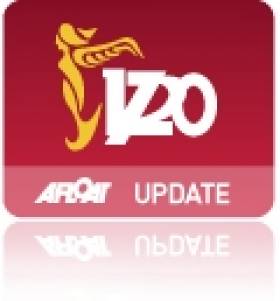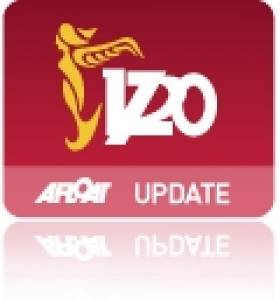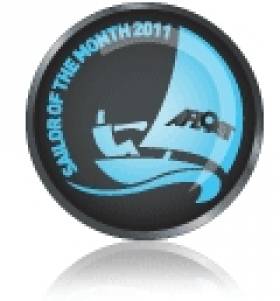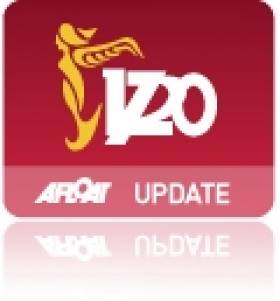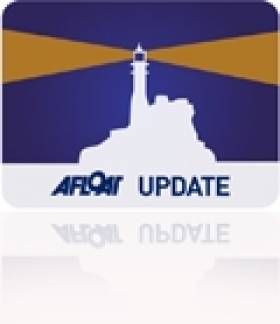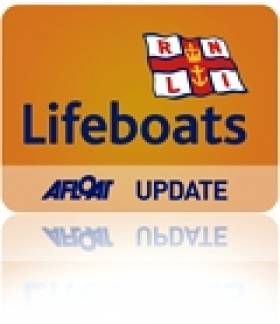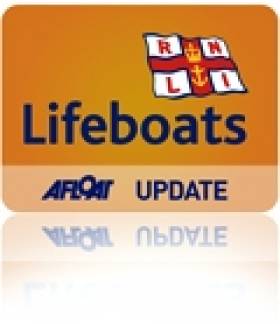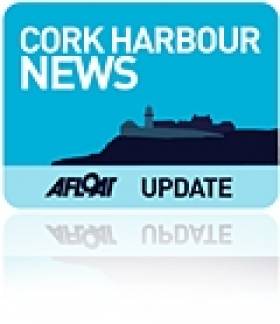Displaying items by tag: Baltimore
Photo Exhibition: People of the Sea / Gens de la Mer
Gilles Perrin selected his subjects by visiting harbours and piers in locations such as Cobh, Baltimore, Castletownbere and Schull. The work was conducted through the Artist in residency programme at Sirius Arts Centre, Cobh and later by a similar residency position at the West Cork Arts Centre which took place over a few months in 2007 & 2008.
People of the Sea is organised in partnership with Veolia Environnement, also the name given for a new MOD70 class (Multi One Design). Veolia Environnement is one of only 12 such high-spec performance yachts which visited Dublin Bay in the summer calling to Dun Laoghaire and a transit of Dalkey Sound (PHOTO's). She was in Irish waters under the skipper Roland Jourdain and crew ahead of her first test, the Fastnet Race held in mid-August. To read more about Veolia Environnement click HERE and also www.canyousea.com/en/
The other participants of the exhibition which have lent their support are the Sirius Arts Centre, The Arts Council, Cork County Council and The West Cork Arts Centre, and iophotoworks. For more information about Perrin who has a master's Degree in photography visit www.art-contemporain.eu.org/perrin/
- Schull
- Baltimore
- Cobh
- castletownbere
- Dublin Bay News
- Dun Laoghaire Harbour
- Fishing News
- Cork County Council
- Sailing news
- Dalkey Sound
- Veolia Environnement
- French Photographer Gilles Perrin
- Gilles Perrin
- People of the Sea/Gens de la Mer
- Alliance Francaise Dublin
- French Cultural Centre Dublin
- Irish Fishing Harbours
- Sirius Arts Centre
- The Arts Council
- West Cork Arts Centre
- The Fastnet Race
- MOD70 class
- Multi One Design
- Irish Fishing Industry
- Roland Jourdain
1720s and Mansfield Enjoy New Lease of Life
'The big man is back' reports WM Nixon this morning in the Irish Independent's Sailing Column. Reports of the demise of the 1720 are greatly exaggerated he concludes in a nice write up for the class and new champion, former Olympian Mark Mansfield here.
Mansfield Wins 1720 Euros in Baltimore
Perfect sailing conditions off Sherkin Island yesterday with a steady 12-16 knot breeze provided champagne conditions for Mark Mansfield and Terry English and the crew onboard Gut Rut to secure the championship with a 10 point lead and a race to spare.
Denis Murphy from RCYC on Aquatack won the first race of the day and Gut Rot won the second while Nicholas O'Leary onboard T-Bone owned by Crosshaven duo Tom Durcan and Clive O'Shea won the final race in the series.
Neil Angle from Brighton YC was the top UK boat finishing eighth.
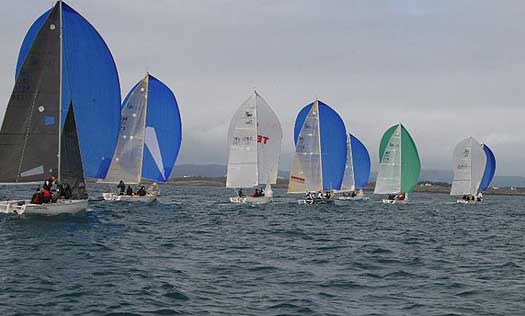
1720s reaching in Baltimore on Saturday. Reader Richard O'Flynn has added more photos to Afloat magazine's facebook page here
Commenting on his win, Mark Mansfield said: 'It was a tremendous event with a very strong tough field sailed in ideal conditions and well organised by Baltimore Sailing Club. No quarter was given nor expected and I think everyone had great sailing over the three days. I have to pay special tribute to my part owner Terry English and the crew, Mike Budd, Joe Bruen and Bernard Fitzpatrick. It was a fantastic showpiece for the 1720 class which is building in numbers significantly.'
Kieran Cotter and Jerry Smith Named Sailors of the Month for August
When Rambler's canting keel snapped off on the evening of Monday August 15th shortly after this mega-machine had rounded the Rock, she was powering at full speed towards the turning buoy, crashing into the lumpy seas which often arise where the steep land juts into the open ocean.

Kieran Cotter and the crew of the Baltimore lifeboat at the capize site. Photo: Thierry Martinez
The catastrophe was total and very sudden. The giant racer completely inverted every bit as quickly as the smallest of racing dinghies. The changeover, from being a highly tuned performer on track for success, into the inverted hell of exploding water, strangling ropes and jagged breaking gear, was at the least totally disorienting, and could have caused panic in less seasoned sailors.
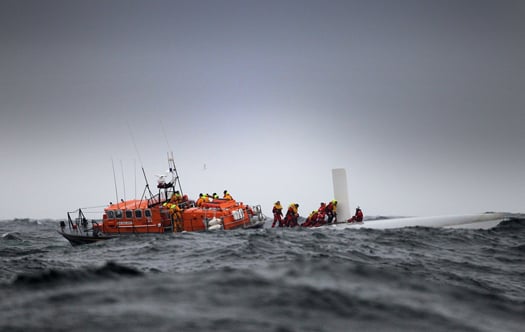
The Lifeboat rescue from the upturned hull. Photo: Team Phaedo
Despite the difficulty of clambering onto the ultra-smooth underside of the huge hull, fifteen of the crew managed to get themselves up to the minimal handhold of the dagger board. But five of those who had been below – some of them off watch asleep – had drifted away from the boat after the monumental struggle of escaping from a small world turned upside down.
The five in the water roped themselves together, but things had taken an ominous turn, as the mist in which the big boat had rounded the Fastnet had now thickened into fog. For a crucial period, visibility was virtually nonexistent as other boat raced past nearby at high speed. And although some emergency radio beacons had automatically activated, the picture was confused with night drawing on.

Drifting crew are rescued. Photo: Team Phaedo
Time was of the essence – even in summer these waters can quickly induce hypothermia. Several agencies were now involved in the rescue, and skilled use of technology narrowed the search area, though in the sea conditions the stricken boat and crew were frequently invisible.
It was the Baltimore lifeboat with Kieran Cotter in command which was first on the scene. Taking off the crew was a challenge, but all fifteen on the upturned Rambler were safely rescued, though an impact between lifeboat and white hull resulted in a streak of lifeboat blue on the yacht which was to be immortalised as "Kieran's kiss".
But that was later, not until after a needle-in-a-haystack search found the other five adrift together in the water, with one already on the edge of coma. They were found by the lifeboat deputy mechanic Jerry Smith, on patrol with a Fastnet Race film crew in his dive boat Wave Chieftain. It was a miracle.
Next morning safely in Baltimore, the weather was already well improved. The previous night's conditions seemed like a nightmare. In calm summery conditions two days later, the Rambler hull was righted off Barley Cove and towed to Baltimore. She'll be restored to full racing trim by Cookson's in New Zealand, presumably with modifications to the design and specification for the canting keel. But that's another day's work. Today, we celebrate the achievement of Kieran Cotter and Jerry Smith, whose seamanship provided the successful focus for a network of rapid work by skilled technologists ashore.
Coverage of the rescue appears in Afloat's Rolex Fastnet Race page
Mansfield Leads 1720 Euros in Baltimore
Current 1720 National Champion Mark Mansfield leads the 1720 Corona Euro Championships in Baltimore after a long opening day of close sailing in steady 10-14 knot conditions.
The 28 strong fleet completed three races off Sherkin Island and Mark Mansfield started the day well with the first bullet.
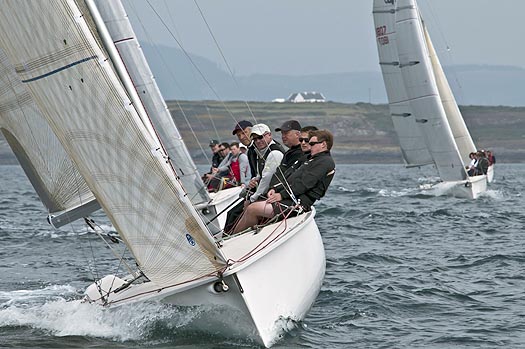
Mark Mansfiled leads the 1720 Sportsboat Euros. Photo: Aidan Coffey
It was a reasonably good day for the O'Leary father and son who are competing against one another. Son Nicholas is onboard T-Bone owned by Crosshaven duo Tom Durcan and Clive O'Shea, having been a close second in the first race he was ocs in the second but went on to win the final race of the day. Anthony meanwhile is lying second over night with a 3, 1, 11 record and local team Peter O'Flynn and John Crotty is second overnight with a consistent 4,4,5.
Race Officer David O'Brien commented on today's racing:
'Conditions were light with strong tides affecting the racing throughout the day. Thankfully wind held fairly steady and we were able to complete the three races with just one general recall'
First gun tomorrow and Saturday is at 1055 with nine races scheduled for the series.
Roll Over Rambler... How to Right a SuperMaxi
Here's video of the salvage and righting operation after the capsize of the super maxi ocean racing yacht Rambler 100 during the Fastnet race 2011.
The 100-foot yacht capsized shorthly after rounding the Fastnet rock, the result it appears of a catastrophic keel failure.
All 21 crew were saved thanks to the work of the Irish emergency services. The footage is taken by Baltimore Sea Safari. All our Fastnet and Rambler 100 coverage is here.
Mayday Prompts Launch of Both Baltimore Lifeboats
Valentia Coast guard first raised the alert at 08:48 this morning requesting the launch of the all weather lifeboat Hilda Jarrett, 3 minutes later the inshore life boat Bessie was tasked too and with it's superior engine power was first on scene. They found the potting boat within 50 metres of the rocks at the North West point of the Western Calf Island. The fishermen had set an anchor in an attempt to keep the boat off the rocks, but the anchor had dragged and they were left holding into their pot lines for safety. A difficult task in Force 5 westerly winds with a 2 metre swell running.
Helm John Kearney manoevred the lifeboat into position and his crew threw a line to the fishermen. The lifeboat then towed the boat upwind and with the assistance of Schull inshore rescue removed the fishing boat from immediate danger.
The allweather lifeboat arrived on scene and stood by until it was clear that there was no further danger. The inshore lifeboat then towed the pot boat to the safety of Schull harbour. The fishermen were unharmed. Helm John Kearney commented ' it was fortunate we arrived when we did another 5 minutes and we would have been pulling the men out of the water'.
Inshore lifeboat Crew : Helm John Kearney, crew Ronan Callanan & Tadhg Collins
Allweather Lifeboat : Coxswain Kieran Cotter, crew Aidan Bushe, Jerry Smith, Cathal Cottrell, Anthony Sheehy, Sean Mc Carthy, Colin Whooley. Slip crew Rianne Smith, Simon Duggan, Gerard Sheehy
Baltimore Lifeboat Rescues Man Overboard
Valentia Coast Guard alerted the Baltimore lifeboat station at 12:43pm and both the inshore lifeboat Bessie and the all-weather lifeboat Hilda Jarrett put to sea. The twin engined Atlantic 75 which has a top speed of 32 knots, reached the casualty within 20 minutes under the direction of Helmsman Youen Jacob.
Crewman Ronan Callanan administered oxygen to the stricken fisherman stabilising his condition, which had been serious due to long immersion in water. Further medical attention was offered by all weather lifeboat crewman Jerry Smith when it arrived on scene 20 minutes later.
Given the seriousness of the fishermans condition it was decided that an airlift was the most appropriate course of action and a rescue helicopter was called.
Helmsman Youne Jacob, commended the Captain and crew of the fishing boat in retrieving the fisherman from the water, which was made even more difficult by the choppy sea conditions prevailing.
The Inshore lifeboat then returned to Baltimore Harbour, However the allweather lifeboat remained at seas, as another distress call was received from a fishing vessel adrift 30 miles offshore.
In current weather conditions it will take them two hours to reach the vessel and several more to tow her back to shore.
Onboard the inshore lifeboat were Helmsman Youen Jacob, crewmen Ronan Callanan and Tadhg Collins.
On board the all weather lifeboat are coxswain Aidan Bushe, Cathal Cottrell, Jerry Smith, Ronnie Carty and father and son team Pat and Diarmuid Collins
1720 European Championships to be Launched on the Lee
The 1720 Sportsboat European Championships and the class national championships will be launched at a "Sailing By The Lee" event on Friday 29th April, 2011 where six 1720's will be raced on the River Lee adjacent to the Headquarters of the Port of Cork. The boats will be brought up river on the Thursday evening and racing will commence at lunch time on the Friday (see below for the Eddie English weather video) which say the class will provide photo and media opportunities at the new marina in the Port of Cork. Each boat will carry sponsorship flags.
In June up to 20 boats go back to their roots when the fleet gathers at Royal Cork Yacht Club for the CH Marine Sponsored National Championships.
A fleet of between 30-35 boats will contest the Corona sponsored Europeans when they set sail off Baltimore in September. There are already confirmed entries travelling from Scotland, Isle of Man, England and Wales while there is also interest coming from Holland where a fleet of eight boats is currently active.
The robust Irish 1720 design has been celebrating a comeback in recent years after cheating death by atrracting a strong following in West Cork, spearheaded by some of the rebel county's top sailors.
The fleet is rapidly becoming the most popular one design keel boat in this part of Ireland. There are now established and growing fleets at Royal Cork, Crosshaven, Kinsale, Baltimore and Schull while Galway Bay also has a growing fleet, racing in Galway Bay. The 2010 Nationals attracted a fleet of over twenty boats,
The series itself will be sailed over a three day period starting on Thursday, 1st September and consisting of nine races in total, three per day. Notice of Race and Entry Forms will be available shortly from Baltimore Sailing Club.
Impressive Views from Dublin and Cork Waterfront Properties
This semi detached holiday home is situated on an elevated site with uninterrupted harbour views just a five minute scenic walk to the village.
Baltimore is a renowned sailing centre with its three sailing schools and two diving centres. Regular ferry trips will take you to the nearby islands of Cape Clear and Sherkin with its lovely sandy beaches.
Vaulted ceilings to dining area, Oak timber beams, open fireplace, teak stairs, paved patio areas are some of the attractive features of this property.
The asking price is €465,000. All the details plus lovely photos here.
The second property to catch our eye while wandering round Howth head in the past fortnight is a detached dormer bungalow, with spectacular uninterrupted sea-views over Dublin Bay. The property is tucked away in a secluded and very private location beside Howth Summit for €650,000. Great views here.





























